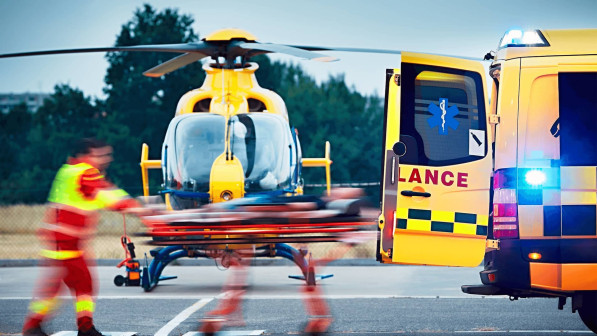- The Need for a Unified Approach
- The Expanding Role of Technology in Emergency Response
- Bringing Teams Together to Transform Processes During Mass Casualty Events
On September 11th, 2001, just a few minutes after the South Tower of the World Trade Center collapsed, a police helicopter pilot circling the remaining tower reported that the top 15 floors were “glowing red” and said he believed the building would soon implode. Four minutes later, another helicopter pilot also warned that he didn’t think the second tower could last much longer. Most of the police officers in the North Tower heard those warnings and were able to evacuate. But that information never reached firefighters, for a simple reason: radio systems for the Fire Department, the Police Department, and the Port Authority Police were all incompatible with each other.
Both the Fire and Police Departments reviewed their responses to the attack. Those reviews concluded that major changes were needed in how the agencies go about their work and prepare for the next disaster, senior officials say.
Although great leaps have been made to better facilitate collaboration for first responders, there is still more we, as tech providers, can do to support great interoperability for all first responder groups in emergency situations.

The Need for a Unified Approach
Independent agencies tend to utilize their own platforms to coordinate crews, and have developed responses and internal operating procedures to meet their unique responsibilities. However, these planning decisions are often made in isolation and without collaboration with other emergency service providers. And this is where things can, and do, go wrong.
As each agency often have different procedures, terminology and platforms, a common and unified approach facilitates collaboration in order to ensure incidents are managed as quickly and effectively as possible.
Today, emergency response providers are looking for platforms and software to provide solutions which mitigate historical issues when mobilizing multiple agencies – issues such as communication breakdowns between agencies, and a lack of situational awareness.
It's about finding solutions which mitigate communication breakdowns to allow command, control and coordination centers to achieve an effective emergency response.

The Expanding Role of Technology in Emergency Response
The ability to have one view of the truth in an emergency can be the make or break between success and failure – especially when emergencies catch us off guard. To ensure the best emergency response, a single data set, in a common format, is vital.
As time goes on, the need to work together for greater mission success increases. This necessity has caused major developments to the industry including:
- Increased interoperability requirements between ground, maritime and aviation assets.
- The development of emerging technologies like drones and UAV’s for reconnaissance and intelligence.
- An increasing requirement for data flows and the associated challenges that come with handling this big data, like the number and type of signals expanding with the development of mesh technology and cube satellite networks.
- Increased severity of natural disasters, requiring assistance from multiple agencies including the military. The recent Australian bushfire season has highlighted the importance of providing first responders and rescue services a platform to collaborate.
It’s our view that over time, not only is more data going to be required, but predictive analysis is going to be needed in the ever-changing environments and our team expects to see technology and software evolve to meet these needs.
Bringing Teams Together to Transform processes During Mass Casualty Events
When a mass casualty event occurs, it commonly triggers a multi-agency response. Initial deployment of emergency teams is soon eclipsed by coordination processes ensuring the management and visibility of emergency teams. Effective software systems provide a reliable platform on which emergency managers can streamline operational processes.
Whilst many incidents can be managed with ease, the more complex the event, the more likely it is to see complications arise.
This can include but is not limited to, significant communication issues, loss of cellular and radio networks, and deployment of right resources to the right places at the right time.
Emergency operations managers comply with agency command by assessing available resources. In order to coordinate asset deployment with medical and support crews, track asset position (in relation to other resources) and provide communication between personnel and the incident management team, operators require a reliable platform to work on.
When coordinating an operational fleet, emergency managers require oversight on:
- Resource and Asset Location
- The skills of the onboard medical and support crews
- Pilot capability: IFR, NVG rated or just VFR?
- The make and model of assets.
- The patient transport capabilities of the operational vehicles and aircraft
Software management systems need to democratise the data to provide intelligence to make quick and effortless decisions with Status Boards showing the real-time location and status of crews, manifesting and two-way voice/text message communications.
Managers require software systems that switch effortlessly through radio, cellular and satellite networks while providing real-time visibility and tracking of aircraft and/or personnel are at any one time.
In addition to functionality, software platforms need to be flexible and designed with an open architecture, allowing both hardware and carrier agnosticism – put simply, operators need to be able to use the devices and hardware that best suit their needs, whilst ensuring discrete systems can work together. Without this ability, interoperability is time-consuming and expensive – not to mention it doesn't take into account the different needs of each operator and emergency sector.
First responders deserve technology that ensures critical operations remain connected. They need assurance that information is delivered to their teams in real-time, utilizing multiple networks for a seamless tracking and communication experience, including radiofrequency, cellular networks or satellite.
Every day, first responders put their own lives on the line to ensure our safety. As a company, the least we can do is make sure they have the tools to protect and serve their communities – and themselves!
Support your first responders with seamless tracking and communication hardware - book a demo here
